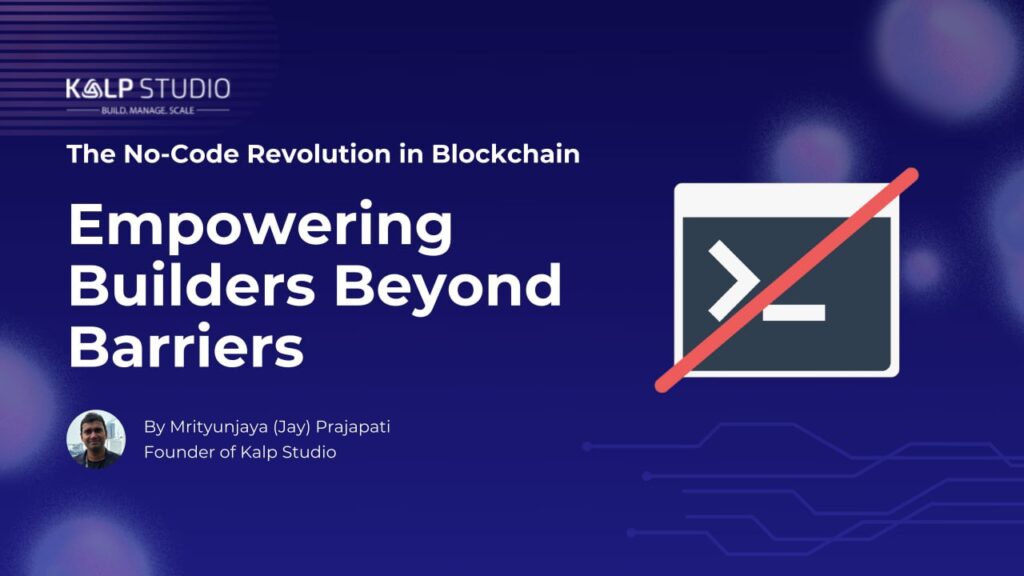Blockchain has always been hailed as a transformative technology, promising decentralization, transparency and empowerment. But let’s be realistic: despite its potential, blockchain remains an exclusive club. Technical complexities, steep learning curve, and high development costs have created barriers that exclude all but the most technically proficient or well-funded players.
Enter no-code platforms. These platforms are redefining the blockchain space, not by simplifying its power but by democratizing its accessibility. They are the unsung heroes behind the growing wave of blockchain adoption, enabling startups, creators, and enterprises to build decentralized applications (DApps) without the need for an army of developers or a degree in cryptography.
But the story of no-code/low code and blockchain goes beyond ease of use. It’s about accelerating innovation, fostering inclusion and rewriting who will build the future. Let’s explore how no-code platforms are reshaping blockchain development and what that means for businesses and creators.
The traditional reality of blockchain development

Building a blockchain-based solution traditionally involves several arduous steps:
- Smart contract programming

Writing secure, bug-free smart contracts requires deep expertise in programming languages such as Solidity, Rust or Vyper. Even a minor mistake can lead to catastrophic vulnerabilities, like the infamous DAO hack that resulted in a loss of millions of dollars.
- Node management
Setting up, maintaining, and scaling blockchain nodes is a resource-intensive task. This requires technical know-how and significant investment in infrastructure. - Channel interoperability
With the proliferation of blockchains (Ethereum, Solana, Binance Smart Chain, etc.), ensuring compatibility across chains adds another layer of complexity to the development process. - Compliance and regulations
Industries like finance and healthcare require strict adherence to KYC/AML regulations, data privacy laws, and industry-specific standards, which add time and cost to development.
These challenges not only slow blockchain adoption, but also limit it to a select few who can afford the necessary resources.
How no-code platforms are transforming blockchain development
No-code tools emerged in response to these obstacles, offering a more inclusive approach to blockchain development. They don’t just simplify workflows: they enable non-technical users to innovate in ways that were previously unimaginable.
Here’s how no-code platforms are revolutionizing blockchain:
1. Abstraction of complexity with Low-Code interfaces
No-code tools replace traditional programming with drag and drop interfaces and visual workflows. This abstraction allows users to focus on what they want to build rather than how to build it. Smart contract templates, modular design components, and automated deployment tools allow users to launch DApps with minimal effort.
2. Democratize innovation in all sectors
From NFT Markets has decentralized finance (DeFi) platforms, no-code tools allow industries to leverage blockchain without requiring specialized skills. For example, a small business can tokenize loyalty points or a creator can create NFTs, all without writing a single line of code.
3. Acceleration of time to market

No-code platforms significantly shorten development cycles. With pre-built templates and streamlined deployment processes, what previously took months can now be accomplished in weeks or even days.
4. Enable multi-chain interoperability
Modern no-code tools are channel independentallowing users to deploy applications across multiple blockchains. This flexibility ensures that projects are not limited by the constraints of a single network.
5. Integrate Compliance as a Feature
Platforms incorporate regulatory frameworks such as KYC (Know your customer) And AML (anti-money laundering) in their tools, ensuring projects meet legal requirements from day one. This is particularly critical for industries such as healthcare, finance and government.
Trends shaping no-code blockchain development
The rise of no-code tools is not happening in isolation. This is part of a larger trend that is reshaping how blockchain is built, deployed and scaled. Here are the main trends driving this revolution:
1. Vertical-specific solutions

No-code platforms go beyond generic use cases to deliver industry specific models. For example:
- Supply Chain DApps: Track shipments, verify authenticity, and automate processes.
- Healthcare apps: Securely share and manage patient data across institutions.
- Gaming platforms: Create tokenized rewards and marketplaces with minimal setup.
2. AI-enhanced workflows
The integration of AI-powered tools in no-code platforms improves usability. AI can suggest optimal workflows, identify smart contract vulnerabilities, and even generate code snippets when customization is needed.
3. Modular SDKs for advanced users
Although no-code tools are aimed at non-developers, they are also evolving to include Modular SDKs for more advanced users. This allows developers to customize and extend functionality while still benefiting from the platform’s core functionality.
4. Decentralized data storage as standard

Platforms are increasingly integrating decentralized storage solutions such as IPFS (Interplanetary File System) to ensure data is secure, censorship-resistant and always accessible.
5. Community-driven ecosystems
No-code platforms foster vibrant communities where users share templates, workflows, and best practices. These ecosystems amplify the value of the platform, allowing users to build faster and smarter.
Challenges and opportunities
Even though no-code platforms break barriers, they are not without challenges:
- Security issues: Simplified workflows can sometimes overlook vulnerabilities, especially in complex smart contracts.
- Scalability Limitations: As projects grow, some no-code tools may struggle to keep up with business demands.
But these challenges also present opportunities for innovation. By continually improving security features, increasing scalability, and integrating with emerging technologies like AI and decentralized storage, no-code platforms can solidify their place as essential tools in the blockchain ecosystem.
The future: blockchain for everyone
Imagine a world where blockchain is as accessible as email or cloud storage. No-code platforms turn this vision into reality, enabling individuals and organizations to innovate without barriers.
It’s not just about making blockchain easier, it’s also about making it meaningful. This is about ensuring that creators, entrepreneurs and businesses can focus on solving problems, building communities and leading change without getting lost in technical complexities.
As someone deeply entrenched in blockchain development, I have seen first-hand how no-code tools are transforming the industry. They’re not just tools: they’re equalizers, bridges that connect visionaries with the technology they need to succeed.
If you are ready to make your blockchain idea a reality, visit Studio Kalp to discover how no-code tools can supercharge your journey.
Post Views: 618




